Related Research Articles

Nemausa is a large main-belt asteroid that was discovered on January 22, 1858, by Joseph Jean Pierre Laurent. Laurent made the discovery from the private observatory of Benjamin Valz in Nîmes, France. The house, at 32 rue Nationale in Nîmes, has a plaque commemorating the discovery. With Laurent's permission, Valz named the asteroid after the Celtic god Nemausus, the patron god and namesake of Nîmes during Roman times.

Melete is a large and dark main belt asteroid. It is a rather unusual P-type asteroid, probably composed of organic rich silicates, carbon and anhydrous silicates, with possible internal water ice. The asteroid is orbiting the Sun with a period of 4.18 years.
Mnemosyne is a large main belt asteroid. It is an S-type asteroid in composition. It was discovered by Robert Luther on 22 September 1859 from Düsseldorf. Its name was chosen by Martin Hoek, director of the Utrecht Observatory, in reference to Mnemosyne, a Titaness in Greek mythology. The orbital period of this asteroid is close to a 2:1 commensurability with Jupiter, which made it useful for perturbation measurements to derive the mass of the planet.

Asia is a large main belt asteroid. It was discovered by English astronomer N. R. Pogson on April 17, 1861, from the Madras Observatory. Pogson chose the name to refer both to Asia, a Titaness in Greek mythology, and to the continent of Asia, because the asteroid was the first to be discovered from that continent.
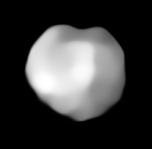
Julia is a large main-belt asteroid that was discovered by French astronomer Édouard Stephan on August 6, 1866. This was first of his two asteroid discoveries; the other was 91 Aegina. 89 Julia is believed to be named after Saint Julia of Corsica. A stellar occultation by Julia was observed on December 20, 1985.
Ate is a main-belt asteroid that was discovered by the German-American astronomer C. H. F. Peters on August 14, 1870, and named after Ate, the goddess of mischief and destruction in Greek mythology. In the Tholen classification system, it is categorized as a carbonaceous C-type asteroid, while the Bus asteroid taxonomy system lists it as an Ch asteroid.

Antigone is a large main-belt asteroid. Radar observations indicate that it is composed of almost pure nickel-iron. It and other similar asteroids probably originate from the core of a shattered Vesta-like planetesimal which had a differentiated interior. It was discovered by German-American astronomer C. H. F. Peters on February 5, 1873, and named after Antigone, the Theban princess in Greek mythology.
Vala is an inner main-belt asteroid. It was discovered by C. H. F. Peters on 24 May 1873, and named after Völva, a prophetess in Norse mythology. One observation of an occultation of a star by Vala is from Italy. 10-μm radiometric data collected from Kitt Peak in 1975 gave a diameter estimate of 34 km.
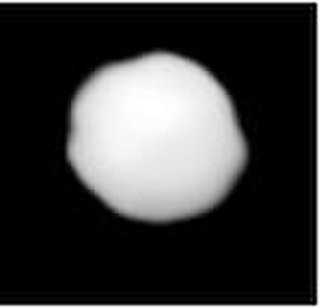
Adeona is a large asteroid from the intermediate asteroid belt, approximately 150 kilometers in diameter. Its surface is very dark, and, based upon its classification as a C-type asteroid, is probably composed of primitive carbonaceous material. The spectra of the asteroid displays evidence of aqueous alteration. The Adeona family of asteroids is named after it.
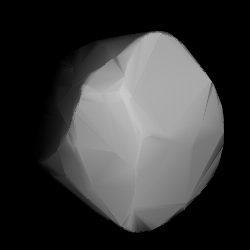
Bertha is a main-belt asteroid. It was discovered by the French brothers Paul Henry and Prosper Henry on 4 November 1875, but the credit for the discovery was given to Prosper. It is probably named after Berthe Martin-Flammarion, sister of the astronomer Camille Flammarion.
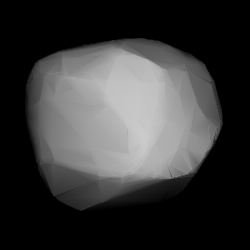
Aemilia is a large main-belt asteroid. Aemilia was discovered by the French brothers Paul Henry and Prosper Henry on January 26, 1876. The credit for this discovery was given to Paul. It is probably named after the Via Aemilia, a Roman road in Italy that runs from Piacenza to Rimini.
Prokne is a main-belt asteroid that was discovered by German-American astronomer C. H. F. Peters on March 21, 1879, in Clinton, New York, and named after Procne, the sister of Philomela in Greek mythology. Stellar occultations by Prokne have been observed twice, in 1984 from Italy and again in 1999 from Iowa.
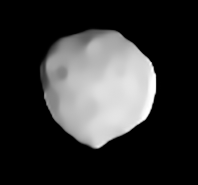
Bamberga is one of the largest asteroids in the asteroid belt. It was discovered by Johann Palisa on 25 February 1892 in Vienna. It is one of the top-20 largest asteroids in the asteroid belt. Apart from the near-Earth asteroid Eros, it was the last asteroid which is ever easily visible with binoculars to be discovered.
Liguria is a very large main-belt asteroid that was discovered by Auguste Charlois on January 21, 1893, in Nice. It is one of seven of Charlois's discoveries that was expressly named by the Astromomisches Rechen-Institut, and was named for the Italian region.
Merapi is a main belt asteroid orbiting the Sun. It was discovered by American astronomer George Henry Peters on May 11, 1904, from Washington, D.C.
Peraga is a minor planet orbiting the Sun that was discovered by German astronomer Paul Götz on January 8, 1905, from Heidelberg.
654 Zelinda is a minor planet orbiting the Sun that was discovered on 4 January 1908 by German astronomer August Kopff. On favorable oppositions, it can be as bright as magnitude 10.0, as on January 30, 2016.

665 Sabine is a minor planet orbiting the Sun that was discovered by German astronomer Wilhelm Lorenz on July 22, 1908.
790 Pretoria is a minor planet orbiting the Sun that was discovered by English astronomer Harry Edwin Wood on January 16, 1912. It is a member of the Cybele group located beyond the core of the main belt and named after Pretoria, the capital city of South Africa.
863 Benkoela is an A-type asteroid orbiting the Sun that was discovered by German astronomer Max Wolf on 9 February 1917 from Heidelberg.
References
- 1 2 Yeomans, Donald K., "381 Myrrha", JPL Small-Body Database Browser, NASA Jet Propulsion Laboratory , retrieved 10 May 2016.
- 1 2 3 Carry, B. (December 2012), "Density of asteroids", Planetary and Space Science, vol. 73, pp. 98–118, arXiv: 1203.4336 , Bibcode:2012P&SS...73...98C, doi:10.1016/j.pss.2012.03.009. See Table 1.
- ↑ "Numbered Minor Planets 1–5000", Discovery Circumstances, IAU Minor Planet center, retrieved 7 April 2013.
- ↑ Ditteon, Richard; Hawkins, Scot (September 2007), "Asteroid Lightcurve Analysis at the Oakley Observatory - October-November 2006", The Minor Planet Bulletin, vol. 34, no. 3, pp. 59–64, Bibcode:2007MPBu...34...59D.
- ↑ Morrison, D.; Chapman, C. R. (March 1976), "Radiometric diameters for an additional 22 asteroids", Astrophysical Journal, vol. 204, pp. 934–939, Bibcode:2008mgm..conf.2594S, doi:10.1142/9789812834300_0469, ISBN 978-981-283-426-3.